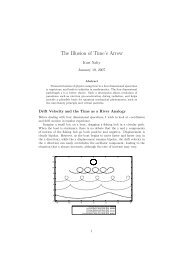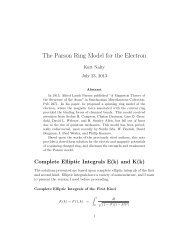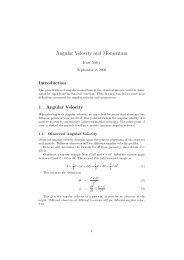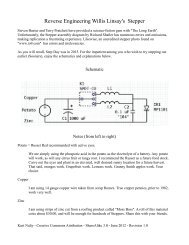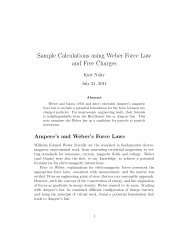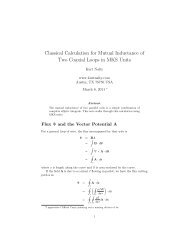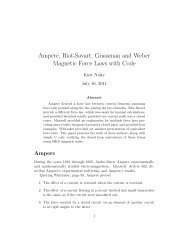Exercises with Magnetic Monopoles - Kurt Nalty
Exercises with Magnetic Monopoles - Kurt Nalty
Exercises with Magnetic Monopoles - Kurt Nalty
Create successful ePaper yourself
Turn your PDF publications into a flip-book with our unique Google optimized e-Paper software.
The magnitude of torsion in three dimensions is<br />
τ =<br />
⃗j · (⃗a × ⃗v)<br />
(⃗a × ⃗v) · (⃗a × ⃗v)<br />
⃗j = d⃗a<br />
dt<br />
F<br />
⃗a = ⃗ m = µq eq m<br />
4π<br />
⃗j = µq eq m<br />
4πm<br />
= µq eq m<br />
4πm<br />
= µq eq m<br />
4πm<br />
= µq eq m<br />
4πm<br />
1<br />
[ m<br />
⃗a × ⃗r<br />
r 3<br />
⃗v × ⃗r<br />
r 3<br />
− 3 r 4 dr<br />
dt (⃗v × ⃗r) ]<br />
[ ⃗a × ⃗r<br />
− 3 ]<br />
⃗r · ⃗v<br />
r 3 r 4 r (⃗v × ⃗r) [ ⃗a × ⃗r<br />
− 3 ]<br />
× ⃗r)<br />
(⃗r · ⃗v)(⃗v<br />
r 3 r2 r<br />
[ ]<br />
3<br />
⃗a × ⃗r 3(⃗r · ⃗v)<br />
− ⃗a<br />
r 3 r 2<br />
Before proceding, I want to comment on these jerk terms. The left portion,<br />
⃗a × ⃗r, is a turning term, bring ⃗ J perpendicular to ⃗a and resulting in<br />
constant acceleration for the electron. The right hand term, −3⃗a(⃗r · ⃗v)/r 2 ,<br />
is a strong damping term for radial motion. I’ll do some simulations shortly,<br />
but at first glance, the jerk should quickly circularize the electron in a flat<br />
orbit.<br />
Simplifying a bit, since ⃗a ⊥ ⃗v,<br />
τ =<br />
⃗j · (⃗a × ⃗v)<br />
(⃗a × ⃗v) · (⃗a × ⃗v)<br />
= ⃗ j · (⃗a × ⃗v)<br />
a 2 v 2<br />
Continuing <strong>with</strong> our development for the torsion term, ⃗a×⃗v is perpendicular<br />
to ⃗a, so the second term in the jerk formula will drop out.<br />
22




